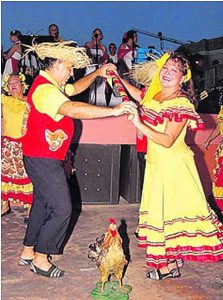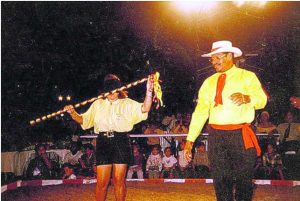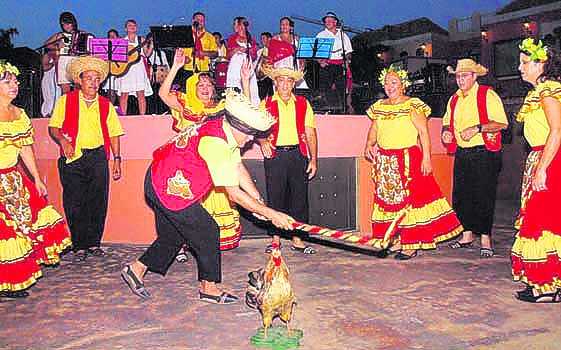Every year on June 24th Aruba commemorates the festive Dera Gai and St. John’s Day. Aruba’s harvest festival ‘Dera Gai’ is now a cultural celebration featuring traditional song and dance. The symbol of the rooster and bright yellow and red costumes are central to events held at various locations including community centers.

Dera Gai which translates to “burying of the rooster” in the local language-is a cultural festival which has been celebrated for about 100 years on Aruba with traditional song and dance. This holiday is rife with both pagan and Christian symbolism reflecting the influences of the Arawak natives and Spanish missionaries on the Island, respectively.
Traditionally, the Dera Gai celebration was centered around an unusual ritual. A hole was dug in the ground, and a live rooster was buried in the hole up to its neck. Blindfolded revelers would be spun around so that they get disoriented and no longer knows the exact location of the rooster and then would be given three tries to decapitate the rooster with a long pole (piñata-style). (The Catholics considered this ritual to be symbolic of the decapitation of St. John the Baptist while the pagans believed that the spilling of the blood would fertilize the earth for the next growing season.) The one to carry out the deed was rewarded with bottles of alcohol and other prizes.

During these festivities, women are dressed with long yellow dresses and yellow hair holders dancing in a choreographed manner. The musicians are dressed in yellow or red with a colorful band tightened on their hips. The instruments used consist mostly of drums and other noisemaker devices. While the music plays, the dancer has to hit the rooster, but the stick is not to touch the ground, or he loses his turn. This is done to symbolize the three times the rooster sang when Saint Peter lied about not knowing Jesus, according to the bible.
Today, a more humane approach is taken. For example, revelers are blindfolded and tasked with locating a flag staked into the ground while swaying their hips to the rhythms of a band. Every now and then, the coordinator of the game fools the blindfolded participants by moving the flag while the game is in progress. Folk dance groups also reenact the burying and decapitation of the rooster using a plastic rooster. Decked out in bright yellow-and-red costumes-the yellow said to represent the bloom of the local kibrahacha tree in the month of June-these groups also perform harvest dance rituals.
Many years ago, bonfires were built on the eve of St. John’s Day in order to communicate the arrival of the holiday to neighbors. The old clippings from the previous year’s harvest would be burnt in preparation for the coming growing season. Fire means purification and it scares away bad luck resulting in a better harvest the following year. Nowadays, the fires are burnt island-wide on St. John’s Day itself, serving as an olfactory reminder of this unique local festival.




















